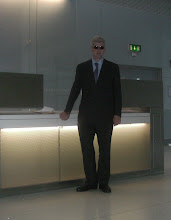The Hologram is a recording of an optical interference pattern created when laser light shone on an object is made to overlap with a separate beam of light that does not pass through the object. When light is shone onto the interference pattern, a 3D image of the original object is recreated.
Traditional holograms, like those on your credit card, are stored on photo-sensitive materials and remain unchanged with time. Smart holograms, however, use materials called hydro gels that shrink or swell in response to local environmental conditions. Such holograms can therefore be used as sensors to detect chemical imbalances in potentially fatal situations.
Smart Holograms, a spin-out company from the Institute of Biotechnology at Cambridge University, has already developed a hand-held syringe to measure water content in aviation fuel tanks - necessary because aeroplane engines are liable to freeze mid-air if there is more than 30 parts water to million fuel!
In health the same composit can be used to detect chemical imbalances could be used by diabetics to check their blood-sugar levels; by patients with kidney disorders to check on adrenaline levels; by security forces to detect chemicals like anthrax after a terrorist attack; or, less urgently but with wide applicability, by glazing firms to detect whether water has crept in between window panes, something that can cause long-term structural damage.
Since the Nobel-prize-winning physicist Dennis Gabor first unveiled their underlying principles, holograms have become widely used as authentication tags to deter copying, and on credit cards, passports, banknotes. They also underpin the technology of supermarket scanners and CD players.
As Chris Lowe and Cynthia Larbey write, "Visual images produced by smart holograms can be made to appear or disappear under appropriate chemical or biological stimuli which makes them ideal for use in Breathalysers, monitoring heart conditions and for various security and smart packaging systems." This development of dry electrolytes are essentially gels in a flexible lattice framework. will allow new ways of viewing these interactive components. for lab results they show new dynamics that haven't been used. There is a lot of development yet to occur at the bio molecular level as they composits are still in their early stages of development but advancements will lead to smaller more powerful and cost effective computer capabilities.
Tuesday, 14 April 2009
Subscribe to:
Post Comments (Atom)



No comments:
Post a Comment